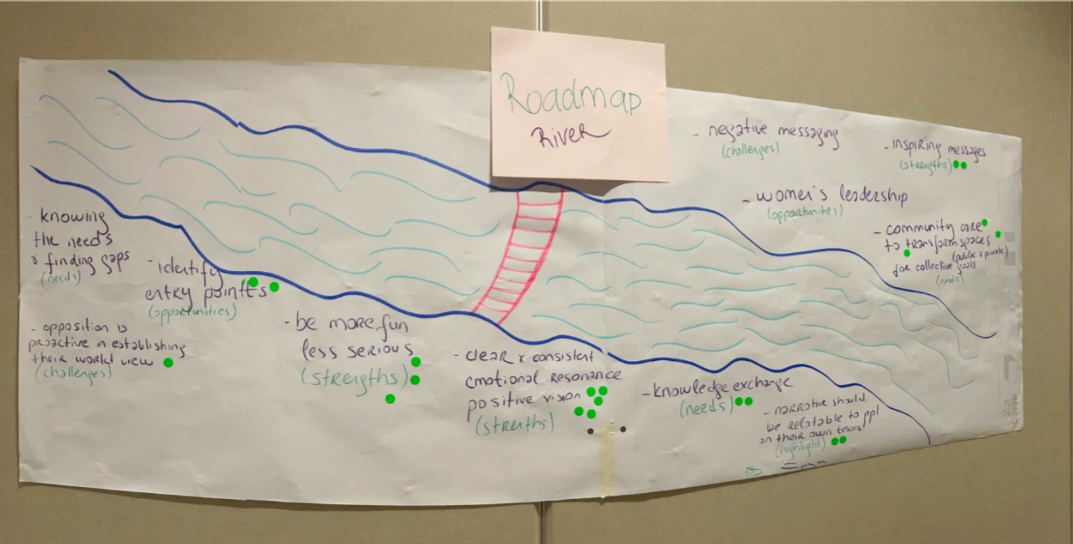What makes narrative resilience?
How can we craft resilient narratives collaboratively while tackling anti-rights waves?
These were the guiding questions of the dynamic and interactive Weaving Narrative Resilience strategy session at the AWID Forum 2024. We, Nayuk and Nazlı Türker, began by exploring the term ‘narrative resilience’—why it matters, how it differs from narrative change, and why this conversation is vital at this moment.
As co-facilitators, we aimed at making our collective and individual work visible by highlighting our scattered contributions to the field of narrative work. The concept of ‘narrative resilience’ emerged from discussions leading up to the strategy session, focusing on what sustains long-lasting narrative transformation.
Over the years, we have dedicated efforts to writing, documenting, and amplifying our own stories, as well as those of our communities. Our individual and collective projects have aimed to foster strategies to challenge the status quo shaped by rising anti-rights and anti-gender movements.
In the session, we reflected on the concept of ‘narrative,’ briefly describing it as a chain of repeated stories that shape beliefs and perceptions in societies.* Many of us are familiar with how marginalized groups are scapegoated through narratives: during the COVID-19 pandemic, LGBTQ+ people were blamed; when elections approached, migrants were portrayed as societal threats; when Israel intensified its war on Gaza, evolving into genocide, it was framed as ‘self-defense.’ These core messages are manufactured and disseminated through well-funded and coordinated narratives by anti-rights actors.
As activists, rights defenders, communicators, and artists, we are often pushed into a reactive mode to counter these narratives. While resistance with strong counter-messaging is important, it is equally vital to create and root narratives that endure beyond time, space, and the influence of anti-rights actors.
Palestinians demonstrate the true power of resilient narratives. They remind us to have conversations with our friends, neighbors, and anyone skeptical of Palestinian liberation, to change the narrative. When well-resourced media spreads misinformation and disinformation, they show us that change is still possible—through street actions, organizing teach-ins, using social media, and leveraging word-of-mouth strategies.
After framing the discussion with central concepts and examples, participants engaged in small group discussions to map out the strengths, challenges, needs, and opportunities for building resilient narratives. Each group used guided flip charts to outline key discussion points, propose potential actions, and highlight standout ideas.
The collective wisdom from the session was distilled into our Narrative Resilience Roadmap River—a visual representation charting urgent priorities. Using sticky dots, participants identified the most pressing issues, ensuring the roadmap reflects the realities and needs of our diverse communities across different geographies.
Key Takeaways from the discussionS On…
…strength
- Effective Messaging Requires Consistency and Clarity
Clear, simple, and repeated messaging is crucial to building strong narratives. - Emotional Resonance and Relatability Matter
Messages should connect on an emotional level and be relatable to diverse audiences. - Inclusivity and Audience Awareness Are Essential
Understanding the audience, including who might be excluded, strengthens impact.
- Adaptability and Expansive Thinking Support Growth
Be flexible in messaging forms and expand language to reach broader groups. - Balance Seriousness with Fun
While urgency and reality are important, incorporating fun and inspiration can make messaging more engaging. - Resilient Narratives Need Resources and Time
Effective narratives develop over time, requiring continuous support and strategic resource allocation.
…opportunities
- Intersectionality and Accessibility Are Crucial
Focus on connecting movements and making language accessible to diverse groups. - Leverage Political and Crisis Moments
Utilize opportunities like elections and crises to mobilize resources and drive engagement. - Narratives Should Be Contextual and Relatable
Ensure messaging aligns with people’s lived experiences and contexts. - Balance Strategic Action with Creativity and Joy
Combine serious actions (e.g., combating misinformation) with creative tactics like humor and positive momentum. - Create Spaces for Collaboration and Dialogue
Platforms like AWID, intergenerational dialogues, and learning spaces enhance collaboration and idea exchange.
…challenges
- Messaging Needs to Be Clear and Hope-Based
Address the use of inaccessible language and provide clear paths for action to inspire hope. - Understand and Counter Opposition Strategies
Recognize how harmful narratives stick and how opposition movements proactively shape their worldview. - Audience-Centric Approaches Are Crucial
Improve understanding of the audience and adapt strategies to their needs and contexts. - Resource and Funding Issues Need Attention
Advocate for longer-term funding to match the timeline needed for societal change. - Combat Despair and Division with Solidarity
The apocalypse of exhaustion and internal division weaken efforts—focus on fighting together and fostering solidarity. - Shift from Campaigns to Narrative Ecosystems
Instead of isolated campaigns, develop sustainable narrative ecosystems to counter misinformation and harmful messaging effectively.
…needs
- Community Care and Collaboration Drive Growth
Building strong partnerships and fostering community care create transformative change and collective success. - Inclusivity and Context Awareness Are Essential
Ensure messaging is inclusive and reflects the cultural and social context of affected communities. - Graceful Engagement Over Confrontation
Adopt practices like calling in rather than calling out, emphasizing grace in interactions. - Human Rights and Intersectional Approaches
Apply human rights principles and consistently evaluate who is included and who is left out. - Knowledge Exchange and Lifelong Learning
Encourage intergenerational learning, unlearning, and relearning to sustain growth and resist limiting ideologies. - Financial Resources and Strategic Messaging
Address the need for funding and refine narrative strategies to balance broad reach with specific focus. - Visibility and Representation Matter
Ensure people can see themselves in the narratives to foster connection and engagement.* Click here for resource recommendations on the concepts and context of narrative, narrative change, anti-rights and anti-gender.
Email us at guclenme.pratikleri@proton.me – what you think, if you have reading or inspiring recommendations or any feedback!
Authors: Nayuk & Nazlı Türker
Insights from the Weaving Narrative Resilience Strategy Session organized by Empowering Practices Initiative @AWID Forum, Bangkok, December 5, 2024
